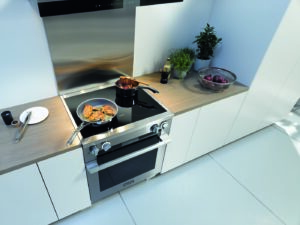Uneven Rack Placement
The positioning of oven racks is a critical factor influencing the even distribution of heat in an electric oven. Incorrect rack placement can result in hot spots and uneven cooking throughout the oven cavity. To optimize heat circulation, ensure that the oven racks are placed in positions that maintain an even distance between the food and the heating elements. Adjust the rack levels based on the specific requirements of your recipe and the characteristics of the dish being prepared. This simple yet crucial adjustment helps facilitate uniform cooking, preventing certain areas from being subjected to excessive heat or insufficient warmth. Paying attention to proper rack placement is an integral part of achieving consistent and satisfactory cooking results in an electric oven.
Issues with Oven Insulation
Inadequate insulation in an electric oven can contribute to uneven heat distribution. If the oven lacks proper insulation or if the insulation is damaged, heat may escape, creating temperature variations within the oven cavity. Check for any visible signs of insulation damage, such as cracks or gaps around the oven door or body. Damaged insulation compromises the oven’s ability to retain heat, leading to uneven cooking results. In such cases, consulting a professional technician for inspection and potential insulation replacement can help restore the oven’s insulation effectiveness, ensuring consistent and uniform heat during cooking.
Thermostat Calibration
A malfunctioning or improperly calibrated thermostat can contribute to uneven heat distribution in an electric oven. The thermostat is responsible for regulating the oven’s temperature, and any discrepancies can result in uneven cooking. If you notice that certain areas of your oven consistently produce undercooked or overcooked food, it may be indicative of a thermostat issue. To address this, consider using an oven thermometer to compare the displayed temperature with the actual internal temperature. If a significant difference exists, recalibrating the thermostat is necessary. Consult your oven’s manual for instructions on how to recalibrate the thermostat, ensuring precise temperature control and uniform heat distribution throughout the cooking process.
Door Seal Integrity
The integrity of the oven door seal, also known as a gasket, is crucial for maintaining consistent heat levels. A damaged or worn-out door seal can allow heat to escape, leading to uneven cooking. Inspect the seal for any visible signs of wear, tears, or damage. If you observe any issues, replacing the door seal is essential to restore the oven’s ability to retain heat effectively. A properly functioning door seal ensures that heat is contained within the oven cavity, preventing fluctuations that can result in unevenly cooked dishes. Regularly check and maintain the door seal to guarantee its integrity and contribute to a more uniform and efficient cooking experience in your electric oven.
Faulty Heating Elements
The heating elements in an electric oven are critical components responsible for generating the necessary heat for cooking. Over time, wear and tear can lead to issues such as hot spots or uneven heat distribution. Visually inspect the heating elements for any signs of damage, including cracks or discoloration. If identified, replacing the faulty heating element is essential to restore the oven’s ability to produce consistent and uniform heat. Regular checks and timely replacement of damaged elements contribute significantly to preventing uneven cooking in electric ovens, ensuring reliable performance over the appliance’s lifespan.
Temperature Calibration Issues
Accurate temperature calibration is crucial for achieving consistent and uniform cooking results in an electric oven. A malfunctioning thermostat can result in inaccurate temperature readings, leading to variations in heat levels. To assess calibration, use an independent oven thermometer to compare the actual temperature with the set temperature. If a significant discrepancy exists, recalibration is necessary. Most oven manuals provide instructions on recalibrating the thermostat to ensure that the displayed temperature aligns accurately with the internal oven temperature. Addressing temperature calibration issues is a practical step in achieving precise and reliable cooking outcomes, enhancing the overall functionality of the electric oven.
Blocked or Damaged Oven Ventilation
Effective ventilation is vital for proper air circulation within an electric oven, influencing even heat distribution during cooking. Blocked or damaged vents can hinder the flow of hot air, resulting in uneven cooking. Regularly inspect the oven’s vents for any obstructions, ensuring they are free from debris or buildup. Additionally, check the functioning of the oven fan, if present. Proper ventilation promotes consistent heat distribution and prevents certain areas from becoming excessively hot or cold during the cooking process. Maintaining clear and unobstructed ventilation is essential for optimizing the performance of an electric oven and ensuring consistently well-cooked meals.
Achieving consistently even heat distribution in an electric oven is crucial for producing perfectly cooked meals. Addressing issues such as faulty heating elements, temperature calibration discrepancies, blocked ventilation, uneven rack placement, insulation problems, inappropriate cookware usage, thermostat calibration, and door seal integrity is essential for troubleshooting and preventing uneven cooking. Regular maintenance, timely repairs, and thoughtful consideration of cooking practices contribute to an optimally functioning electric oven. Recognizing these common issues and taking proactive measures, such as seeking professional help, ensure that your appliance remains reliable, providing a dependable and efficient platform for culinary endeavors. Whether through replacing damaged components, recalibrating settings, or practicing proper oven usage, a well-maintained electric oven enhances the cooking experience and ensures that every dish emerges from the kitchen with precision and flavor.
